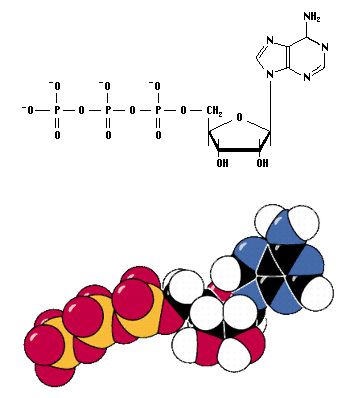- A chemical reaction that is exothermic releases more energy than it takes in; an endothermic reaction requires more energy to run than it gives off.
- We've seen how enzymes can cause exothermic reactions to happen spontaneously, by lowering the activation energy.
- But enzymes by themselves cannot force an endothermic reaction to happen -- there must also be a source of energy!

ATP (top: shown as a formula. bottom: space-filling "Ping-Pong-ball" model)
- ATP can break a bond between two of the phosphate groups (groups of phosphorus and oxygen atoms) that it carries. This produces a molecule of ADP (adenosine diphosphate) and a phosphate ion (PO4, often just abbreviated as Pi).
- The reaction ATP -> ADP + Pi is exothermic -- it releases energy.
- It can be coupled to endothermic reactions that cells must carry out to live.
- EXAMPLE: Muscle consists of two basic proteins, both of which form long, parallel filaments: actin and myosin. (There's other proteins involved as well, but for our purposes we need not know about them.)
- Myosin binds by its "head" to actin.
- When a molecule of ATP comes into contact with a myosin molecule, it breaks down into ADP and phosphate. . . and transfers the bond energy to the myosin. . .
- . . . and causes the myosin molecule to change its shape! This lets it "ratchet" one notch down along the actin molecule.
- ATP is like cash in your pocket -- you can use it to buy almost anything quickly and easily, and most people always have some cash on hand, but it's not efficient to carry enormous wads of cash.
- Most people store their wealth in more stable forms (bank accounts, savings bonds, IRAs, home equity, etc.) and convert those to cash only as they need it.
- In the same way, most cells and other organisms store energy in the form of starches, sugars, or lipids, and convert those into ATP only as needed.